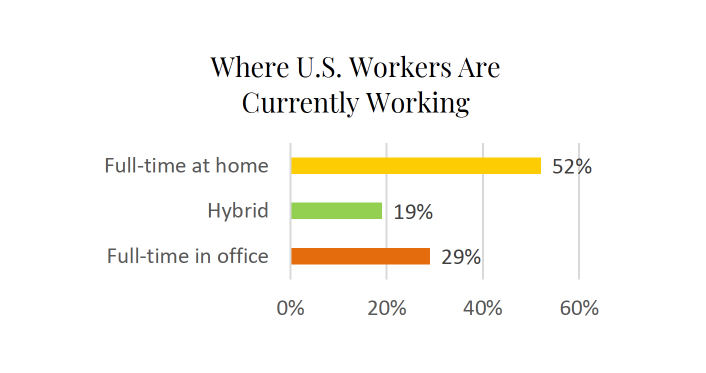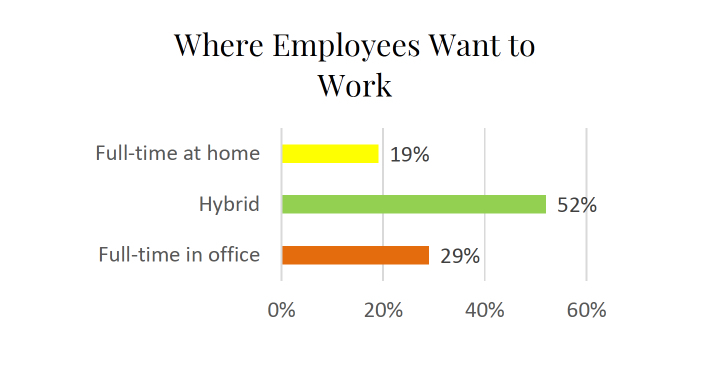28 - Feb - 2021
Because One Size Doesn't Fit All
As we’ve entered 2021 and we see the ramp-up of COVID vaccine production, distribution and inoculations, our communities are becoming more optimistic that returning to a more normal and less confined way of life is on the horizon.
To-date, most organizations have placed their focus on business continuity throughout the pandemic.
Introduction:
As we’ve entered 2021 and we see the ramp-up of COVID vaccine production, distribution and inoculations, our communities are becoming more optimistic that returning to a more normal and less confined way of life is on the horizon.
To-date, most organizations have placed their focus on business continuity throughout the pandemic.
Now, companies are beginning to chart their plans for re-entry from the pandemic and many are grappling with a range of competing realities related to a post-pandemic environment.
The focus of this paper is on the dueling forces behind the challenges and opportunities for bringing employees back to their offices.
Where the Workforce is Today:
In their Summer/Fall 2020 U.S. Workplace Survey, Gensler, a leading global architecture and design firm, they report slightly more than half of all workers in the U.S. are currently working from home on a full-time basis.

This has been somewhat dictated by guidance provided by federal, state and local health officials in an effort to get the spread of the virus under control. That coupled with efforts to remain safe while also managing the needs of others within their households such as children who are attending schools virtually.
Beyond safety and these other practical matters, employees have reported they feel more productive in completing the tasks associated with their jobs when working from home because there are fewer interruptions throughout the day. They’ve grown accustomed to the flexibility of working where they want and when it’s convenient around other aspects of their lives.
But, even through the eyes of employees, it’s not all rainbows and unicorns. New employees are finding it more difficult to get the training necessary to be effective. Younger employees feel disconnected from the organization and miss the camaraderie that comes from the workplace environment.
Many employees who don’t have a dedicated home office space with the furniture and technologies required to be comfortable and effective find working from home draining. In a research study fielded by market research firm Doris found they are finding working from home in some ways is adversely impacting their work-life balance. One of the respondents said:
There are times it feels like I’m living at work, not working from home.
Focus Group participant
Fall, 2020
The Pitfalls of a Distributed Workforce:
While the technology advances of videoconferencing and employee chat software have become essential platforms to sustain employees and organizations through this forced virtual environment, it’s not without a cost to both employees and to the organizations for whom they work.
Companies and organizations have invested significant amounts of effort, energy and resources into building a culture that attracts and retains employees, prospects and customers. They’ve developed and measure employee engagement, retention and satisfaction. They’ve chosen an office space and designed the interiors to be a reflection of who they are as acompany and as a brand.
For employees, they miss the spontaneity that comes from seeing their co-workers in the hallways and at the coffee bar. Often times, those conversations that occur organically throughout the day produce new ideas or solve challenges. These types of occurrences don’t happen naturally with a remote workforce. As a result, it isn’t just a hit to company culture, it impacts the long-term health of the organization.
Cushman & Wakefield found that when employees are in the workplace 4-5 days per week, there is greater than an 80% likelihood of them crossing paths with their co-workers in any given week. When employees are in the office 1-2 days per week, the likelihood of a coincidental meeting is reduced to less than 20%.
As a result, critical aspects for the long-term vitality of an organization that are enhanced through collaboration are degraded. Creativity, innovation, strategy, core elements that are enhanced by multi-function and multi-disciplinary collaboration are impeded.
Where Does It Appear We’re Heading?
Before the pandemic, numerous companies tried the work from home experiment. Flexibility for employees, reduced real estate costs for the company and many other sound reasons led to those attempts. More often than not, take IBM and Yahoo! as leading examples, the experiment was abandoned. Now, as many companies consider the same, it’s quite possible that it will work for some. Most organizations seem to be exploring a full return to work or some implementation of the hybrid model tailored to their organization’s situation.
Most employees are looking to get back to the office to varying degrees. We’re social creatures and employees are missing the interactions with their colleagues. The same Gensler survey show employees wanting to either get back to the office full-time or the hybrid model that gives them the choice based on what they have to do to be successful that day. The Gensler survey indicated that 71% of employees want to return to the workplace all or part of the time.

The Challenge That Poses for Commercial Space Design:
How do organizations navigate their way through this maze of competing or conflicting needs and wants to contribute to the long-term imperatives of the organization?
How do we create a workplace environment that accommodates the varying needs of those coming into the workplace on a daily or even hourly basis while also assuring their safety when they come into the office?
How do we adapt the way we think about the workspace to make it a place that employees wantto be in order to foster collaboration, creativity, innovation and strategy?
How do we approach workplace and technology planning so employees can effectively work from home where they’re focusing on their task list while also providing them with the technology tools so they can participate in meetings with the same levels of professionalism?
Envisioning the Workplace for the Future:
These are steep challenges that require reimagining how we design and construct the workplace environment. We have an opportunity to take cues from other industries as we develop solutions for the post-pandemic return-to-work.
Think about the newfound latitude we gained when laptops became widely accessible. We were free to move around wherever we wanted. Also, when cell phones replaced landlines, we were able to be in touch with co-workers, family and friends no matter where we were in the world. This kind of untethering can also be applied to the way we design future workplaces.

Anticipating that the number of employees working in the office will vary from day-to-day, the number of scheduled meetings and training sessions along with smaller, impromptu discussions, the fixed nature of walls and furniture becomes an impediment.
But, by designing the workplace with the purposeful and intentional plans to untether, we can see space that accommodates the dynamics anticipated in our post-pandemic return-to-work and we can start looking at alternatives that are better suited to the future workplace experience.
Recent advances and innovations in a broad range of architectural products, allow us to create any number of space configurations large and small. Reconfigurable walls and screens can be used to form meeting rooms for collaboration. Or they can form even smaller individual workspaces to enhance employees’ safety and privacy when they are working independently. By combining the right mix of furniture and architectural products, you can create any number of combinations of individual workspaces and meeting rooms to deliver for your employees and the varying requirements of the hybrid model. Then, layer in portable technology packages that include state-of-the-art microphones, speakers and webcams that can be set up, plugged in and ready to go—whether in the office or for workers in their home offices—without needing IT help—that enhances their professionalism whether they’re in the office or at home.
While permanent offices and workstations will likely remain part of future office plans, by untethering certain elements of the workspace, we’re now able to provide far greater latitude to accommodate a more dynamic workforce and workplace with a broad range of functionality while also supporting the continued adherence to safety protocols.
At CI Select, we’re pioneering the future with our proprietary concept of The Conforming Workplace—a workplace that conforms to the needs of the business and the employees, at that moment and in a moment. A workplace that works in harmony with the ever-changing dynamics of your organization. Every organization is unique and no single approach can be applied universally.
If you’d like to find out more about how The Conforming Workplace can fit into your plans as you prepare your return to work, please contact Dan Tramelli at 314.686.6976 or dtramelli@ciselect.com.
Get this and more delivered to your inbox.
Sign up now for email updates from CI Select.
Previous Article
What Do Website Design & Office Design Have In Common?
Read ArticleNext Article
